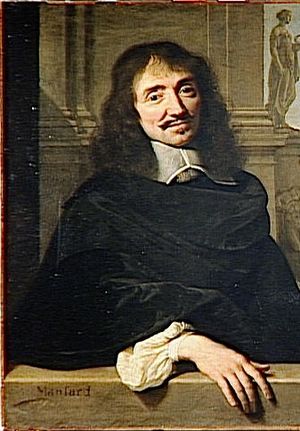François Mansart facts for kids
Quick facts for kids
François Mansart
|
|
|---|---|

François Mansart, detail of a double portrait of Mansart and Claude Perrault, by Philippe de Champaigne
|
|
| Born | 23 January 1598 |
| Died | 23 September 1666 (aged 68) Paris
|
| Nationality | French |
| Alma mater | studio of Salomon de Brosse |
| Occupation | Architect |
| Buildings | Château de Balleroy, Temple du Marais, Château de Maisons, Church of the Val-de-Grâce |
| Projects | Château de Blois |
| Design | plans to redesign the Louvre and the royal mausoleum at Saint-Denis |
François Mansart (born January 23, 1598, died September 23, 1666) was a famous French architect. He is known for bringing a new style called classicism into the Baroque architecture of France. Experts say he was one of the most skilled French architects of the 1600s. His buildings were known for being very refined, subtle, and elegant.
Mansart is also famous for a special type of roof. It's a four-sided roof with a double slope. The lower part is steeper and has windows. This design creates more living space in the attic or garret of a building. This type of roof is now called a mansard roof, named after him!
Mansart's Career
François Mansart was born in Paris. His father was a master carpenter. Mansart didn't go to school to become an architect. Instead, his family helped train him as a stonemason and a sculptor. People believe he learned how to be an architect in the studio of Salomon de Brosse. Brosse was a very popular architect during the time of King Henry IV.
From the 1620s, Mansart became well-known for his unique style and skill. However, he was also seen as a very stubborn and difficult person. He was a perfectionist, meaning he wanted everything to be absolutely perfect. Sometimes, he would even tear down parts of his buildings just to start over! Because of this, only the wealthiest people could afford to hire him. His projects were said to cost "more money than the Great Turk himself possesses."
Early Works
One of his earliest buildings that still exists today is the Château de Balleroy. A chancellor (a high-ranking official) for Gaston, Duke of Orléans asked him to build it. Construction started in 1626. The Duke was so happy with the result that he asked Mansart to update his own home, the Château de Blois, in 1635.
Mansart wanted to completely rebuild the Duke's old royal residence. But his full plan wasn't carried out. Only the north wing was rebuilt according to Mansart's design. He cleverly used classical styles in this part of the building. In 1632, Mansart designed the Church of St. Mary of the Angels. He was inspired by the famous Pantheon in Rome when he created it.
Later Projects and Challenges
Many of Mansart's buildings were later changed or torn down. The best example of his mature style that is still well-preserved is the Château de Maisons. This building is special because it still has its original inside decorations, including a beautiful staircase. The building is perfectly symmetrical, and Mansart paid a lot of attention to its details. It is thought that this building helped inspire the Neoclassicism style in the 1700s.
In the 1640s, Mansart worked on a convent and church called the Val-de-Grâce in Paris. This was a very important job given to him by Anne of Austria, the Queen of France. But people said he spent too much money. So, he was replaced by another architect. However, the new architect mostly followed Mansart's original design.
In the 1650s, Mansart faced problems from political enemies of Cardinal Mazarin. Mazarin was the prime minister, and Mansart often worked for him. In 1651, these enemies published a pamphlet (a small book) called "La Mansarade." It accused Mansart of being very wasteful and of playing tricks.
After Louis XIV became king, Mansart lost many jobs to other architects. His designs for updating the Louvre palace and for a royal tomb at Saint-Denis were never built. For the Louvre, he wouldn't even submit detailed plans. Some of his ideas were later used by his grandnephew, Jules Hardouin-Mansart. François Mansart died in Paris in 1666.
Gallery
See also
 In Spanish: François Mansart para niños
In Spanish: François Mansart para niños





